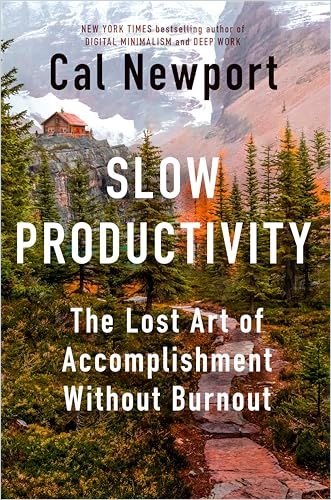Many knowledge workers are burned out and fed up with a frenetic pace of work. Best-selling author and computer scientist Cal Newport suggests a new performance management paradigm that promises to restore both sanity and productivity.

Easy Does It
The COVID-19 pandemic pushed many knowledge workers’ already-troubled relationships with the notion of productivity toward breaking point. In response, millions participated in the “Great Resignation” — quitting high-pressure jobs in favor of less demanding ones. Others embraced “quiet quitting”: giving a minimum performance at work.
Clearly, knowledge workers are deeply unhappy. For many, their days consist of endless activities unconnected to concrete goals or metrics that would give a sense of productivity and accomplishment. Often, they work under the eagle eye of managers who crack the whip but have no way of knowing whether their people’s busyness is adding up to anything.
For teams, the price is overwork, stress, and exhaustion. A 2021 McKinsey and Lean In study noted a significant increase in the number of knowledge workers who view themselves as “often” or “almost always” burned out. Noting this unsustainable state of affairs, computer science professor Cal Newport suggests abandoning the notion that busyness equals accomplishment, and instead adopting a counterintuitive philosophy he calls “slow productivity.”
To embrace slow productivity…is to reorient your work to be a source of meaning instead of overwhelm, while still maintaining the ability to produce valuable output.
Newport is a founding member of the Center for Digital Ethics at Georgetown University, where he teaches. His best-selling books include Deep Work and A World Without Email. He draws on a wealth of research and expertise, using his trademark combination of accessibility and sensibility. Newport brings compassion for workers’ plight, appreciation for the bottom-line demands of business, and insight into how knowledge work gets done.
In a nutshell, Newport’s concept of slow productivity comprises three principles: do fewer things; work at a natural, variable pace that allows for rest and consideration; and prioritize quality over quantity. Put together, Newport says, this approach will ensure big-picture results for organizations while supporting the engagement and well-being of employees.
Do Less
The first principle of slow productivity — do fewer things — means reducing both the size and number of work obligations. On a day-to-day basis, Newport advises workers to focus their energy on just one target each day, delegating or automating tasks as much as possible and applying efficiency-boosting tactics such as holding short “docket-clearing” meetings in lieu of drawn-out, asynchronous email conversations to clarify pending tasks.
Newport advocates a switch from “push-based” work processes — where completion of a project stage instantly triggers the onset of the next stage — to “pull-based” processes, whereby new phases of work begin only when people are ready to take them on. A pull-based approach eliminates backlogs, respects workers’ capacities, and facilitates focus, he says.
For workers who find themselves stuck in push-based processes, Newport offers some workarounds that individual workers can implement on their own to simulate a pull-based system, including a “holding tank” for projects awaiting their turn.
Take Your Time
The second slow productivity principle — work at a natural pace — allows workers to get in touch with their natural rhythms for greater focus and higher performance. Newport notes the individualized work habits of creators and innovators, such as journalist John McPhee, who spent extended periods of time contemplating his approach to an upcoming article before he began the actual writing — famously, by lying on his back on a picnic table in his backyard.
Newport advises workers to cultivate their own unique relationships with time. Permit yourself to progress unevenly, he says, varying the intensity of your work, as well as the settings in which you perform it, to suit your needs. Isaac Newton worked out the details of calculus in the peaceful English countryside, Newport notes, while Maya Angelou preferred nondescript hotel rooms for writing her poetry.
Slow productivity, more than anything else, is a plea to step back from the frenzied activity of the daily grind.
Newport says you can free up time to focus on your highest-priority projects by reducing the number of small tasks and appointments on your agenda. If you must attend a meeting, block out time of equal length for “me” time when you’ll work toward your goals.
Aim High
In the late 1990s, Steve Jobs turned Apple around by scrapping most of the company’s product line to focus on developing just four computers — a simplification that enabled Apple to stand out in innovation and quality. This kind of pared-down move is integral to implementing the third principle of slow productivity: obsess over quality.
Don’t seize every opportunity, Newport says; you can’t generate quality work when you’re overloaded. When you instead prioritize the work that matters most and focus on quality, you’ll create more opportunities for yourself in the long term.
Newport recommends identifying those core activities within your job where high quality is a must. For example, a professor must produce high-quality research papers, a manager must lead a high-functioning team, and a graphic designer must create compelling artwork.
Do It Yourself
Throughout, Newport addresses workers directly, offering a roadmap to implementing the concept of slow productivity at their own desks. For those who lack the autonomy to control their work processes, Newport admits that shifting to a slow productivity approach will likely pose challenges. But for those who enjoy a reasonable degree of control over their workflow, Newport points to the opportunity to transform their workday, approach their work with more intentionality and purpose, avoid burnout, and tap into their full potential.
We’ve tried the fast approach for at least the past 70 years. It isn’t working. The time has come to try something slower.
Refreshing and readable, Newport’s treatise aims to help free knowledge workers from hustle culture and the endless to-do lists of “pseudo-productivity” in favor of purposeful accomplishment. Newport’s proposal appears radical amid the frenzy rampant in today’s workplaces, with their entrenched ethos of hyperactivity. But with workers themselves leading the way, slow productivity might become, if not a new norm, at least a saner alternative. May calm heads prevail.





